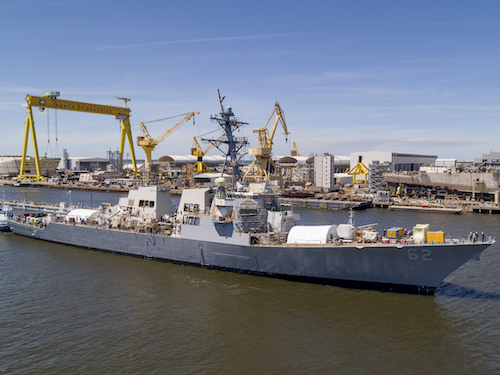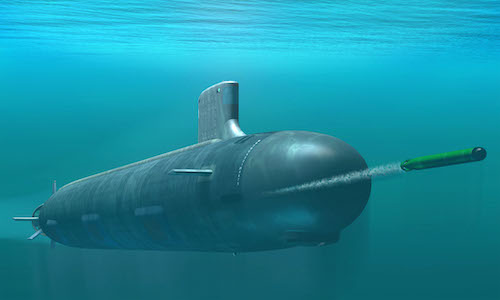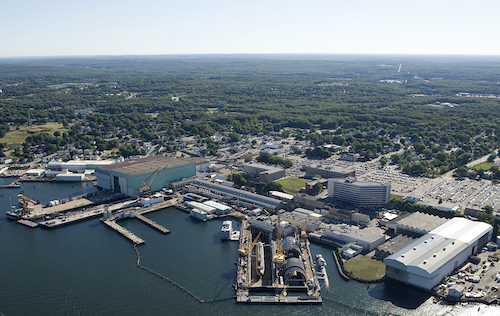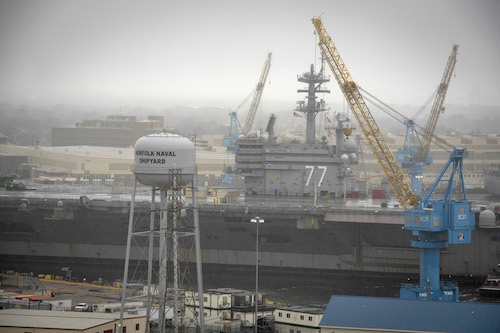President Trump’s 2021 budget cuts new ship construction by 20%, killing 10 new ships – some for this year – and putting thousands of shipyard jobs at risk, including many IBEW jobs. This is despite his promise only one year ago to increase the fleet by 30% by 2030.

|
| Pascagoula, Miss., Local 733 members at the Huntington Ingalls Industries - Ingalls Shipbuilding shipyard face at $650 million in lost new construction, possibly more, with the cancelation of 5 of the Flight III Arleigh Burke destroyers
|
Trump’s budget sets the U.S. Navy on a course to fall more than 50 ships short of the 355-vessel goal it set for itself only two years ago. It even fails to meet the Obama Administration’s fleet target which was regularly attacked by candidate Trump four years ago.
On the campaign trail, former Vice President Joe Biden attacked the last minute and haphazard seeming budget cuts for its impact on American security and workers.
"China and Russia are aggressively challenging our navy’s ability to project power and to protect American interests. I am committed to continuing to make important investments in our naval fleet with ships like those being built by IBEW members, here in Mississippi and around the country,” Biden said.
The cancelation follows closely on a Feb. 20 executive order that would allow the Department of Defense to abolish the collective bargaining rights of civilian labor unions.
“This is a sword of Damocles hanging over every union defense worker,” said Government Employees’ Department Director Paul O’Connor “Trump’s version of creating a more efficient and effective government is by stripping workplace and labor rights from a million federal employees and their unions.”
Taken together, the fleet cancelations and the threat hanging over every CBA in the national security supply chain creates chaos in some of the nation’s most important industries said Political and Legislative department Director Austin Keyser.
“They pose a genuine threat to the livelihood of our members and the safety of our country,” Keyser said.
A Wave of Cancelations


|
| Groton, Conn., Local 261 members working at General Dynamic’s Electric Boat shipyard face one of the largest single cuts, the loss of the nearly $4 billion Virginia class submarine.
|
If passed into law, the Trump budget cuts would add only 11 ships to the navy fleet in the next five years. Among the projected 10 canceled ships includes a $3.86 billion Virginia Class Attack submarine built by members of Groton, Conn., Local 261 at General Dynamics Electric Boat.
Pascagoula, Miss., Local 733 members and the Machinists at Bath Iron Works in Maine expected to build 13 of the Flight III Arleigh Burke destroyers at an average of $1.82 billion each. Five were canceled in the president’s budget.
Local 733 also faces the cancelation of C-America Class Amphibious assault ship LHA-9.
Total cuts could rise to $650 million at this shipyard alone.
The FFG(X) guided-missile frigate and the Common Hull Auxiliary Multi-Mission Platform program are also on the chopping block.
The budget plan would also accelerate the decommissioning of three dock landing ships, four cruisers, and the first four littoral combat ships.
Fewer ships also means less work for the men and women at the Portsmouth, Norfolk, Puget Sound, and Pearl Harbor naval shipyards who maintain the fleet.
And while the budget also funds $160 million in shipyard upgrades, that money has been diverted in the recent past O’Connor said.
“This is bad for our members. We have been expecting this work. But it is worse for our nation’s defense,” O’Connor said. “Attack submarines are a primary focus of Chinese and Russian military development.”
Congressional leaders from both parties attacked the budget proposal, with 17 senators signing a letter encouraging the President to go back to the drawing board.
“Fast attack submarines will help ensure our asymmetric advantage and undersea superiority during a potential conflict with near-peer adversaries, and investment in the Virginia Class program is an indicator of progress toward countering Russian and Chinese aggression,” the letter read, adding that a delay would contribute to “supplier instability.”
The cuts couldn’t have come at a worse time for America’s shipyards, O’Connor said. The Navy is about to replace the fleet of nuclear submarines that carry nearly 70% of the ballistic nuclear arsenal.
This monumental undertaking will absorb nearly 40% of the U.S. Navy’s shipbuilding budget for the next two decades. The first Columbia-class submarine will cost $14 billion over three years, and the whole 12-ship class will cost in excess of $109 billion.
“Cuts before Columbia gets under way will be difficult to replace,” O’Connor said.
Maintenance Workforce Under Threat as Well

|
| President Trump’s 2021 budget cuts new ship construction by 20%, creating a ripple effect in both new construction and in maintenance yards like Norfolk Naval Shipyard, here with the aircraft carrier USS George H.W. Bush (CVN 77) in for service.
|
In addition to the loss of work and jobs at the shipbuilding yards, if the surface-ship and submarine build-rates are interrupted, the impact would ultimately be felt by the four Naval maintenance and repair shipyards.
There are IBEW locals at the Portsmouth, Norfolk, Puget Sound, and Pearl Harbor as well as at the Submarine Intermediate Maintenance Facility in Point Loma San Diego.
“These Naval shipyards perform maintenance and modernization on the Navy’s submarine fleet, both fast-attack and ballistic, as well as aircraft carriers. We can’t maintain them, if they don’t build them,” O’Connor said. “Any disruption in funding, including both new-construction and maintenance, creates tactical and strategic instability which, ultimately, adversely impacts hiring and performance. This is of significant importance when your business is national security.”
We’re already seeing the impact of a failure to investment in the naval maintenance workforce and facilities. Chief of Naval Operations, Admiral Michael Gilday recently told Defense News that the Navy is getting less than 40 percent of its ships out of maintenance on time.
This is an improvement over early in the Trump administration when on-time completion rates fell into the 20-percent range.
The U.S. Navy has also deferred maintenance on the nation’s shipbuilding facilities. One of the more startling shortfalls is at the Norfolk Naval shipyard where the Ship Maintenance Facility has been cited numerous times for life safety violations, including for a building that has been deemed so hazardous, fire guards must be posted any time it is used.
Smaller than Obama
As recently as December, acting Secretary of the Navy Thomas Modly confirmed that U.S. policy is to deploy a 355-ship fleet.
“It was also the president’s goal during the election,” Modly said. “We have a goal of 355, we don’t have a plan for 355. We need to have a plan.”
But under Trump’s budget, the fleet will shrink to 287. The U.S. Navy will also fail to meet the goal of 66 submarines by 2048, shrinking the fleet by 20 percent.
“The Congress wants them, national security requires them, and the president promised them, yet they are not there,” O’Connor said.
Despite campaigning on a 355-ship Navy, President Trump is on track to leave office with a fleet smaller than the 308 ships called for by the Obama administration.
Congress has been much more aggressive, appropriating funds for 50 ships during the same time frame, a 26 percent increase over the White House’s requests.
“The fleet has grown under Trump; but because of the long timelines associated with shipbuilding, the fleet was always going to grow in his first term due to shipbuilders’ backlog left over from the Obama era,” O’Connor said.
And there could be lasting and far-reaching consequences for cutting the ships and the submarine in such a last minute and haphazard way, O’Connor said. It took substantial political and industrial muscle to get to construction of two Virginia-class submarines per year, he said.
“We aren’t talking about a pair of shoes; these are one of the most technologically sophisticated machines in human history. It takes years to get the feeder industries in place to build a nuclear submarine,” he said.
The military and related industry have been gearing up to meet this need for years, O’Connor said.
“Where do those people go? Do they even stay in the industry or will they take these highly important skills, retool, and get out of the business?” he said. “At the stroke of a pen, Trump has created chaos.”